 |
 |
 |
| |
Responder-relapser (RR) patients might obtain benefit in liver fibrosis, after anti-HCV chemotherapy, in comparison to non-responders (NR) or non-treated (control) HIV- HCV coinfected patients
|
| |
| |
Reported by Jules Levin
51st International Conference Antimicrobial Agents & Chemotherapy (ICAAC)
Sep 17-21, 2011 Chicago
Carton JA1, de la Fuente B2, Collazos J3, Asensi V1
1Infectious Diseases Unit, Hospital Universitario Central de Asturias, Oviedo University School of Medicine, 2Infectious Diseases Unit, Hospital de Cabueñes, Gijon; 3Infectious Diseases Unit, Hospital de Galdacano, Vizcaya, all in Spain.
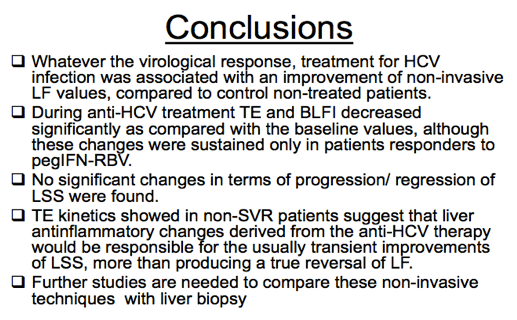
ABSTRACT
Background: The possible benefit of unsuccessful HCV therapy on liver fibrosis (LF) is debatable.
Patients and methods: 130 HIV-HCV coinfected patients that ultimately failed to eradicate HCV were evaluated at baseline, end of anti-HCV therapy and 38 (25-46) months afterwards, by elastometry (TE) and mathematical biomarkers (MB): APRI, Forns, FIB-4 indexes. Patients completed at least 12 weeks of standard therapy with Peg-IFN α + Ribavirin; 118 patients reluctant to HCV therapy constituted the control group. Liver fibrosis was assessed by biopsy (Metavir) or ET at baseline and only by ET afterwards. A combined scale of liver stiffness was made putting together both values, using as cut-offs: F2α7.2kPa, F3α9.4kPa, F4 α14kPa.
Results: 49 and 81 patients composed the RR and NR groups of non-SVR. There were significant differences in baseline characteristics between both groups in HCV genotypes distribution and duration of HCV-therapy. No differences were found in demography, RNA-HCV load, ET, MB or Metavir-ET stage at baseline. During HCV treatment TE and BLFI dropped significantly as compared with the baseline values, although these changes were sustained only in patients responders to pegIFN-RBV. No significant changes were found in terms of progression/ regression of LSS between both groups and controls.
Conclusions: Whatever the virological response, treatment for HCV infection is associated with an improvement of non-invasive values of LF measurement, compared to control non-treated patients. Significant worsening of LF markers and progression to cirrhosis was observed in NR and control groups. Nevertheless, RR group experienced slowing of liver stiffness evolution with transient improvement.
Introduction & Objectives
Virological eradication with anti-HCV therapy associates with biochemical and histological improvement, and decreased liver morbidity and mortality.
PegIFN-RBV could improve liver fibrosis (LF) even after virologically unsuccessful anti-HCV therapy (Vergniol 2009).
Patients with initial viral clearance that subsequently relapse showed intermediate outcome in death/transplantation and morbidity/ complications of cirrhosis in a prospective study (Morgan 2010)
Fibrosis progression can be measured noninvasively by transient elastometry (TE) and biochemical indexes (BLFI).These LF markers can be influenced by anti-HCV treatment.
This study was aimed to investigate the possible benefit of unsuccessful anti-HCV therapy on LF estimated by non-invasive procedures, TE and BLFI (APRI, Fib-4 and Forns indexes) and by changes in liver stiffness staging (LSS) in 3 years of follow-up.
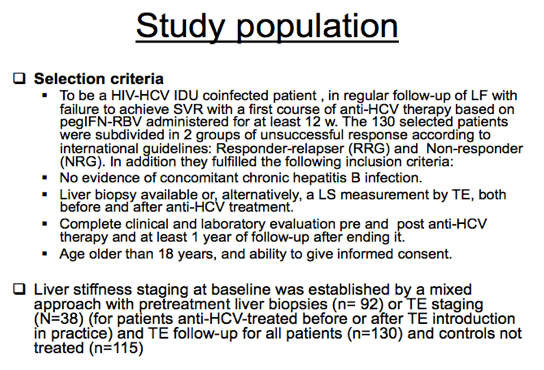
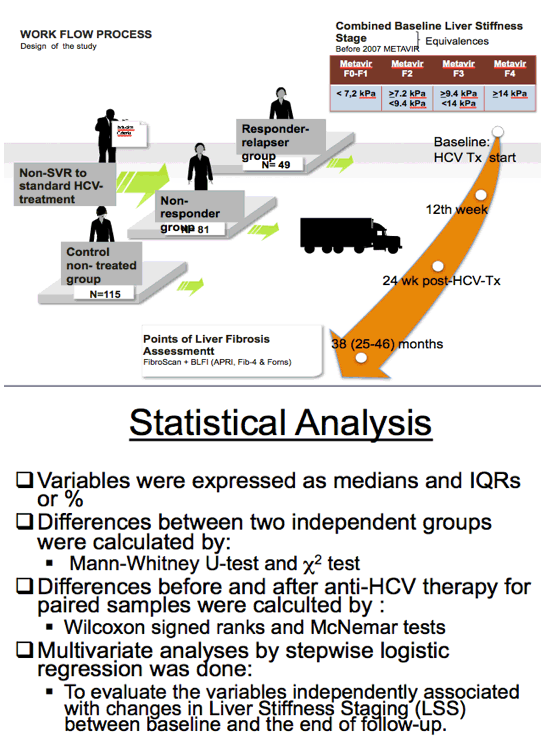
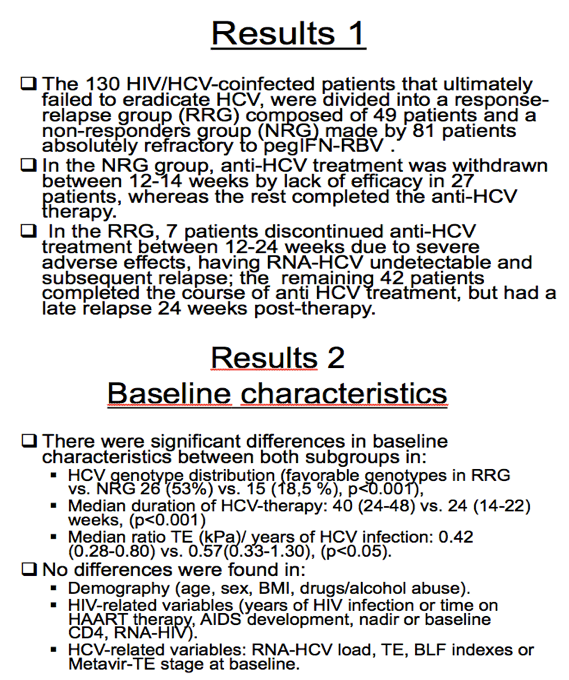
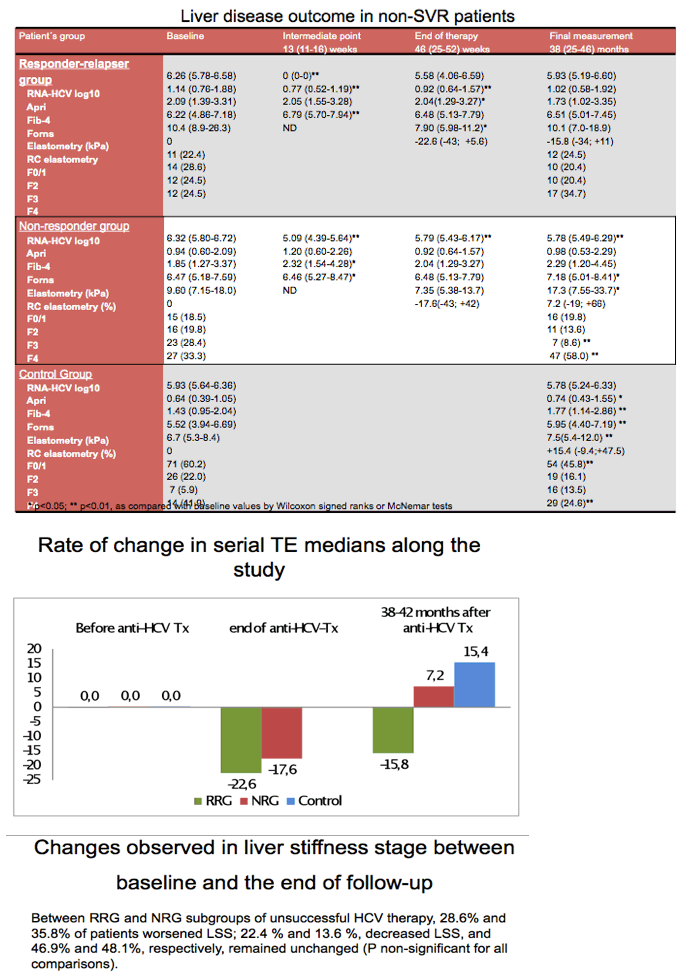
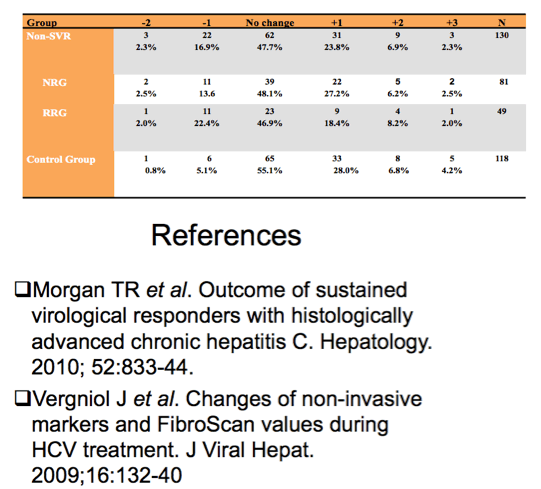
|
| |
|
 |
 |
|
|